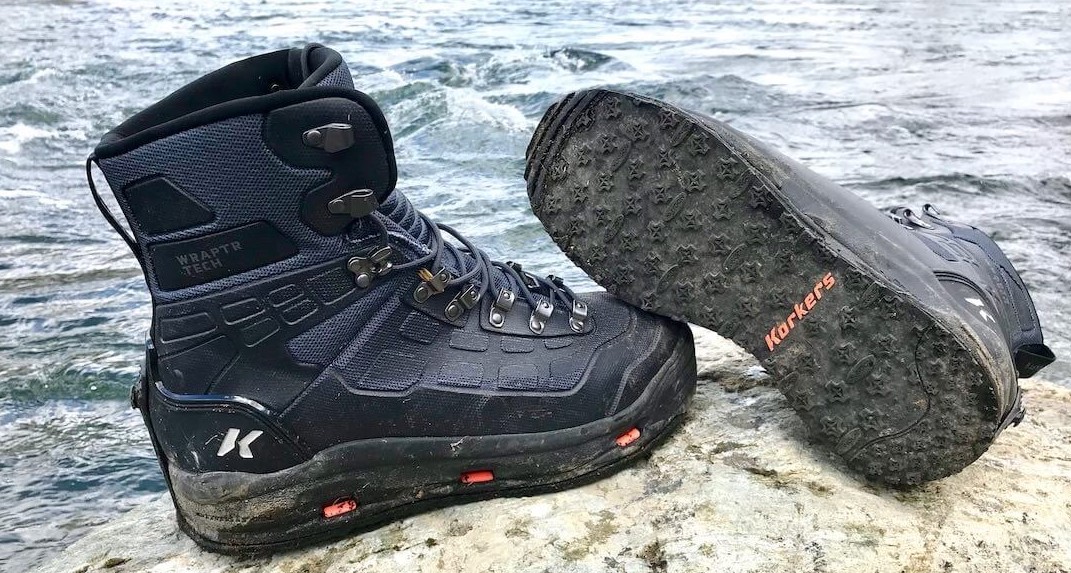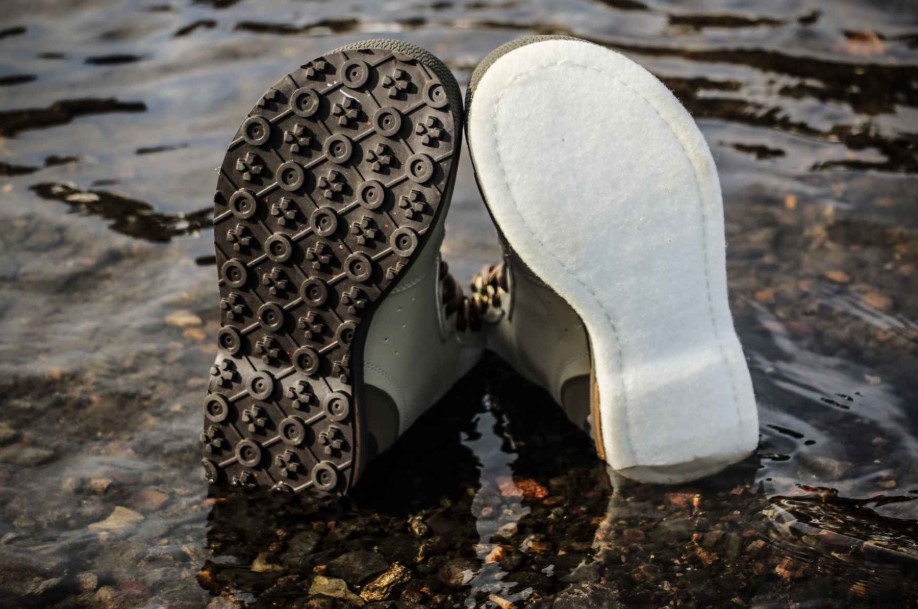 Any experienced or even entry-level angler knows that having the right gear when fishing can make the difference. One of the pieces of fly fishing gear that unexperienced angles may skip is the wading boots. You only know how important they until you don’t catch any fish and go swimming with the fishes instead. Wading boots can help you stay safe when fishing and not end up with a broken leg at the end of the fishing trip.
Any experienced or even entry-level angler knows that having the right gear when fishing can make the difference. One of the pieces of fly fishing gear that unexperienced angles may skip is the wading boots. You only know how important they until you don’t catch any fish and go swimming with the fishes instead. Wading boots can help you stay safe when fishing and not end up with a broken leg at the end of the fishing trip.
Why are wading boots essential?
The most crucial benefit that wading boots bring to the table is the safety that they provide. Due to their design and build, the wading boots ensure reliable traction so angles can walk over the wet rocks or slippery terrain without worrying about a fall.
But safety isn’t the only good thing about this type of boots. They’re also very comfortable as anglers have to stay out there all day long. Some aching feet or tired legs isn’t something they are willing to have when the fishing trip is over.
Luckily for anglers, they can find good quality wading boots for an excellent price. If there’s one piece of gear for which anglers should always pay the extra buck, the wading boots are it. The range of prices is very generous and the more you’re willing to pay, the more you should expect in terms of materials or durability.
Other reasons why wadding boots are essentials
It’s pretty standard for anglers (especially the new ones) to skip the part about the wading boots and go with the very first pair of boots that they find. However, they should keep in mind that fly fishing is no safe sport. Sprained ankles from falling into the river are more often than one may think. Even if wearing wading boots doesn’t mean you’re never going to tumble again, you may reduce that risk by a lot when wearing functional wading boots that give you stability and traction on wet and slippery terrain.
Thanks to the materials, construction, and design in lug patterns, the wading boots are capable of offering amazing traction and stability on slick terrain. It doesn’t mean that you should walk carelessly on some slippery rocks. The angler still needs to pay attention, but the risk for one to get injured when wearing wading boots is a lot smaller.
Functional wading boots also ensure fantastic ankle support. As when your ankles are safe and secure, the chances for one to lose their balance isn’t that high.
What to check on wading boots?

When it comes to wading boots, some aspects are worth to be considered as they sure make the difference between the good and the poor ones:
- Rubber sole
You want your wading boots to come with a rubber sole as they present excellent resistance to abrasion, as opposed to the traditional (and less and less popular) felt soles. The rubber sole is going to take the wear for a reasonable amount of time. Unlike the beginning of rubber soles, nowadays rubber soles are designed to provide adequate traction and stability on wet terrain. The material is soft, which makes it easy to adjust to the ground, without sacrificing on your balance.
- Lightweight
Anglers are going to spend a lot of hours walking so the wading boots need to be as light as it can be. Chunky boots are going to get your legs tired, and best wading boots weigh in less than a pound. The rule of thumb is that the lighter they are, the more comfortable you’ll feel.
The weight isn’t the only thing to check, though. You should also take a look at the uppers of the boots. You want them to be made of synthetic leather or microfiber. A lightweight material, yet long lasting, flexible and easy to dry is a vital feature for wading boots.
- Efficient drainage
Reliable wading boots are going to drain efficiently. When the drainage isn’t working correctly, the boots get heavy, and it’s only a matter of time until you get tired and unable to fish right. Reliable wading boots feature additional drainage canals in the midsoles, which increases the efficiency of the drainage system.
- Solid ankle support
Ankle support is vital as anglers are going to walk a lot, on various surfaces throughout the day. Superior ankle support is going to help your legs take the efforts a lot better. You know that the wading boot is the right one when there is no “rolling over” of the ankle.
- Lace and lacing system
You want the wading boots to come with good quality laces that don’t tear out fast from getting wet regularly. The lacing system should work nice and comfortable so that the anglers don’t lose precious time.
- Hydrophobic coating
It’s pretty standard for the manufacturers to apply treatments (DWR is one) for making the fabric even more hydrophobic. DWR (Durable Water repellent) is a treatment based on fluoropolymer and Gore-tex is one famous example within the category. Thanks to this type of treatment, the material isn’t going to absorb water that easy. The material is also going to get back to its weight as water leaves the material a lot faster. You may restore the quality using the waterproofing spray.
Rubber sole or felt soles for your wading boots?

The main difference between the models of wading boots out there comes from the material used for the soles, with rubber and felt as first options.
- Rubber sole wading boots
Back in the day, the rubber sole wading boots weren’t that popular amongst the anglers (for the obvious reasons). Some years ago, rubber sole wading boots had poor traction and came with numerous problems, with the rubber remaining attached to the rest of the boot as the main one.
However, due to development within the industry, rubber sole wading boots have become the best option at the moment. They ensure efficient traction, are well made, long lasting and lightweight. They’ve become the no.1 choice for the anglers as they’re stable, safe and lightweight. They perform well on both land and slippery terrain.
Even if it’s not fundamental, rubber sole wading boots are legal in all states, and they’re going to stay that way for years to come.
- Felt bottom wading boots
Unfortunately for the rubber sole wading boots, when it comes to traction on wet, slimy terrains, it’s still the felt wading boots that perform the best.
Many anglers appreciate how the traction of felt wading boots feels on the slippery rocks. Even if the rubber sole wading boots provide reliable traction on wet surfaces, it still doesn’t seem to be as good as the one that felt bottom wading boots offer. Wet rocks are the best surface to prove it to you.
Unfortunately for the felt wading boots, they only provide excellent traction on wet surfaces, and once they’re not in the water anymore, there’s nothing good to talk about. Wearing felt wading boots is a good idea on some wet rocks, but once you run over some dirt or dry tree trunks, the situation takes for a turn.
Another common issue for the felt sole wading boots is their poor durability. These boots do tend to wear out a lot faster, especially when worn outside the stream. Sure, you can always change the felt as it’s replaceable, but do you want to go through that over and over again? Besides, felt may fail right when the angler needs it the most.
On top of everything else, it seems that felt wading boots are a method of introducing invasive species to a non-native river. Felt dries slowly, and it’s highly absorbent too, which piles up to the list of downsides. As an angler travels from the river to river throughout the day, he’s going to introduce (by accident) various non-native species to the rivers he goes to in a day. It’s why the felt wading boots have become banned in Alaska and some other states.
Is it tricky to find the right size and fit?
Not wearing the right size of wading boots is a common mistake amongst users. It’s important to highlight that most manufacturers are adjusting the sizing which results in half/ one size bigger than in the regular shoes.
Most anglers are going to wear the wading boots with some stocking foot waders, so it makes sense that the wading boots come in big right from the beginning. Some may want to wear neoprene booties that are also going to make the feet bigger, especially when you add some comfy socks into the mix.
No matter which brand you go with, you’re going to find the sizing charts especially when you shop online. For instance, at https://archerygb-ontarget.org/best-wading-boots/ you’re going to be able to scroll through a nice variety of wading boots. You can also find out which model fits the best a specific condition. But the shop provides lots of info about archery, hunting, climbing, so you only need some time to check their guides, helpful info and everything else.
One last piece of advice!
As long as you got it that wearing wading boots is essential for your angling, you only need the time and money to get yourself a good pair. The last thing you want is to end up to the emergency room and not at home, telling the stories about your fishing trip for the day!

